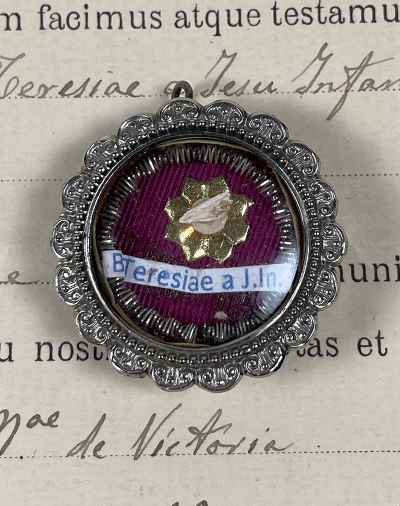Saint Therese de Lisieux († 1897) popularly known as "The Little Flower of Jesus," was a Roman Catholic French Discalced Carmelite nun widely venerated in modern times. After nine years as a Carmelite religious, having fulfilled various offices, and having spent her last eighteen months in Carmel in a night of faith, she died of tuberculosis at the age of 24. Thérèse has been a highly influential model of sanctity for Catholics and for others because of the "simplicity and practicality of her approach to the spiritual life". Together with Saint Francis of Assisi, she is one of the most popular saints in the history of the church. Pope Pius X called her "the greatest saint of modern times". She is a holy patron of Gardens of Vatican City, Missionaries; France; Russia; HIV/AIDS sufferers; radio care-a-thons; florists and gardeners; loss of parents; tuberculosis; and the Russicum; Alaska.
Rare 1923 documented reliquary theca with first-class relic of Saint Therese de Lisieux (St. Teresa of Infant Jesus)
Round gilt metal reliquary theca housing rarely-seen pre-canonization first-class ex ossibus (from the bone) relics of Saint Therese de Lisieux (of Infant Jesus). The substantial relic is affixed to a red silk ground decorated by silver wire ornamentation and identified in Latin on a typeset cedula label as B. Teresiae a J. In. (the Blessed Therese of Infant Jesus). In the authentics document, the relics are described as "Ex ossibus B. Teresiae a Jesu Infante Virginis" (from the bone of the Blessed Therese of Infant Jesus, Virgin). On the back, under a protective cap, the theca is secured with a perfectly-preserved seal of red Spanish wax bearing an imprint of a coat of arms of the Discalced Carmelites order. The relic is accompanied by an original matching authentics document issued and signed by the Fr. Roderic a S. Francis of Paula, the Postulator General of the Carmelite Order in 1923.
Additional Info
- ID#: 222-RSCR-8
- Size: 30 mm (1 1/4 inches) across
- Age: ca. 1923
- Origin: Rome, Italy
- Materials: metal, glass, silk
- Price: SOLD!
Additional Images of this Item
Online Store & Services
Information
Quick Link
Information
Quick Link
SAVE 5% from your first purchase when you subscribe to receive our infrequent mailings with updates on new arrivals, exclusive offers, and fascinating stories on relevant subjects.








 Поменять язык на русский
Поменять язык на русский 